Iceland, a place of stark natural beauty, has been carved by the ice caps that surround and cover her and moulded by the fiery lava that flows through her veins. Her people proudly call her the Land of Ice and Fire. This is a place for the true adventurer, a place where you can dive between two continental plates, surf in the icy Atlantic under the midnight sun, hike through smouldering fields of lava, venture deep into the heart of one of Europe’s biggest glaciers and follow the course of ancient lava through underground tunnels.

Quick Navigation
ToggleIceland a Work in Progress
Iceland is literally a work in progress, slowly but surely growing in size. It lies on the North Atlantic Rift where the tectonic plates of Eurasia and North America are slowly tearing themselves apart. This is the only place on earth where you can see the edges of the two continents above water and take a walk between them.
Eleven percent of the interior of Iceland is capped by more than seven thousand two hundred square kilometres of glacial ice. It is in one of the world’s most active geothermal hotspots, containing lava deserts and geothermal pools and geysers. It boasts Europe’s largest glacier and the most voluminous waterfall, one of nearly ten thousand located in Iceland. Rivers and streams thread their way through black sand deserts and landscapes of almost impossibly green mosses, ferns and birches. Lakes have taken residence in the rents in the earth, sparkling with clear glacial water.
And yet, Iceland barely featured on the tourist map until the massive volcanic eruption of 2010 grounded planes in Europe in the biggest aviation shutdown since World War Two.
Journalists converged on Iceland and discovered the pristine natural beauty that is hers. They started to write numerous Iceland travel tips and the country has since become such a popular destination that the number of tourists that visit her shores each year numbers close to five times her population of 350 000 people.
When to Travel to Iceland
The shape of your Icelandic trip will be determined by the time of year that you choose to travel. Daylight hours, landscapes, temperatures and accessibility differ substantially during the various seasons of the year.

Iceland is not as cold as you may have imagined. In winter the temperatures hover around freezing point, but in December there are no more than four hours of daylight. In winter the price of everything from airfare to hotels and entertainment drops by up to a third. This is also when you can get to see the Northern Lights in all their glory. During this time of year, the countryside will be draped in a beautiful thick layer of snow, but many areas will be inaccessible.
In the summer months, the sun sets for only a few hours each day and even then, the night is little more than a long sunset. For those who wish to make good use of the long daylight hours, this is the best time to visit.
Getting to Iceland
Iceland is part of Nordic Europe and Schengen visa rules apply.
There are regular flights into Iceland from Europe and North America and ferries run from Europe on a regular basis. Icelandair offers the option of a stopover for up to seven nights when flying between North America and Europe. For this, there is no additional cost.

The airport is forty kilometres outside of the capital city Reykjavik and you can get a bus or cab to your accommodation in the capital.
The best way to see Iceland is by camper van, or you could consider
The road is single carriage most of the way and in some areas, it deteriorates to gravel so you should add gravel insurance to your rental. You can set your own pace if you self-drive. On the other hand, the guided tour offers some insight into the history and the geology of this enchanting land.
Where to Stay
Most towns and villages in Iceland have their own camping ground and this is one of the best ways to spend a night in Iceland. There are also places where you can camp in the wild without a permit if you have fewer than three tents. It is advisable to seek permission before camping on or around farmland. Campervans may only be used in a campsite.

There is a decent selection of hotels and guest houses in the towns. Try the family guesthouses, farmhouses and mountain cabins when travelling around the Ring Road for a genuine Icelandic experience.
Useful to Know
Food is very expensive. An average lunch could set you back by $30. All hostels, campsites and guest houses have kitchen facilities. Making your own food is the best way of ensuring that you have money for your other adventures. Tipping is not necessary. Alcohol is very expensive as it is heavily taxed.
The water is clean and drinkable so you do not need to purchase bottled water.
Take your own towels to the thermal pools. They are expensive to rent. Expect to take a shower before you enter communal baths. There is little chlorine in the water and the local people are fussy about personal hygiene.
All Icelanders speak good English as they are expected to pass the language before leaving elementary school.
The weather is changeable. You need to be prepared as conditions can change from warm to cold and wet very quickly. The wind can pick up quickly, bringing with it an icy edge.
Always be aware of the fragile environment. Driving off road is illegal. The crime rate in Iceland is one of the lowest in the world.
If that’s your first visit, you can get some extra tips from this handy guide to Iceland attractions for first timers.
Reykjavik
Most holidays to Iceland start in the most northerly capital in the world, Reykjavik. The city has a lively café culture and a vibrant nightlife, one of the best in Northern Europe. Here you will find jazz sessions, comedy theatre, craft beer bars, drag shows, and cabarets. The city is small, pretty, cosmopolitan and expensive. The streets are lined with colorful, low-rise buildings. In the distance, the snow-capped mountains are always visible.

The cuisine in the city is superb with a wide selection of restaurants serving local and international food. Icelandic food runs the gamut of lamb or fish and the more exotic sheep’s heads, whale meat or fermented shark.
It is best to explore Reykjavik on foot. Visit the music bars, the boutiques and the cafes, art galleries, museums, and public gardens. Get a view of Reykjavik from the tower of the Hallgrimskirkja Lutheran Church. It is 74 meters tall and is one of Iceland’s largest structures. It has a 360⁰viewing platform and from it, you can see the colorful streets of Reykjavik and the harbor bay. In the front of the church is a statue of Leif Erikson, the man who sailed to North America five hundred years before Columbus.
Learn all about local marine life at the Old Harbour. On the weekend there is a colourful flea market in the harbour, where you can purchase local crafts such as the splendid jerseys for which Iceland is famous. From the harbour, you can take a boat ride to one of the nearby islands. On Viðey you’ll find the Lennon Ono peace tower. The islands are full of birds that include puffins, arctic terns and cormorants.
Take a class at the Icelandic Elf School in Reykjavik. You’ll be taught by people who claim to have met an elf or two. Many Icelandic people believe in elves. In a 2007 survey, 37% of Icelandic people said that they believed that elves possibly existed.
If you’re in Reykjavik during the winter months hitch a ride to find the Northern Lights. In summer, take a boat out to the islands to see the puffins nesting.
The Blue Lagoon
Part way between the airport and Reykjavik, the Blue Lagoon is one of the most photographed areas in Iceland. Comprised of man-made thermal pools in shade of electric blue. The water temperature never drops below 38 degrees Celsius, winter or summer. Soaking in these warm outside pools whilst surrounded by snow and ice is surreal, and the surrounding countryside adds to this dreamlike fantasy as the black rock backdrops and surrounding steam create a whimsical setting.
West Iceland
Snæfellsnes Peninsula
Snæfellsjökull glacier is the volcano that took centre stage in Jules Verne’s Journey to the Centre of the Earth, and it looms over the landscapes on the peninsula. Dramatic scenes unfold as you make your way around the coast.
The sea cliffs at Snæfellsjökull are simply remarkable. The columned basalt cliffs feature evenly spaced block columns that tower up to fourteen metres into the heavens. They are trimmed by golden beaches so unlike the black beaches found elsewhere in Iceland. On a good day, you’ll find common or grey seals sunning themselves on the sands.
Here black lava fields flow down to soft pink sand beaches, and hills and rocks are covered with emerald green mosses and ferns. The area is full of mineral springs and thermal pools. The place names carry stories of human’s interaction with trolls and elves.
One of Iceland’s loveliest natural harbours can be found at Arnarstapi. Here you can walk the massive basalt cliffs, and view the harbour and the beaches from above, or hike along the beach and explore the arches and caves below.
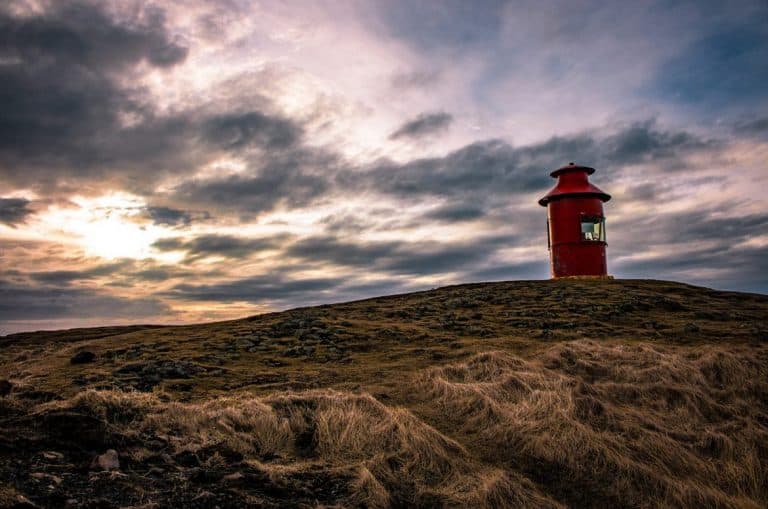
Fishing villages, lighthouses and splendid and unusual rock formations are dotted all along the coastline. In Stykkishólmur, the largest town on the peninsula, you can visit the unusual Library of Water. Here roof high glass tubes contain water from each of the glaciers in Iceland. It is a beautiful exhibit created by an artist. The library is located on a hill, so you can view the town and the harbour from above. One of the world’s largest eider farms is located here, and you can make the acquaintance of the ducks at the eider centre.
Into the Heart of a Glacier
One thousand two hundred and sixty meters above sea level you can now enter the world of glacial ice. The world’s largest manmade glacier tunnel was launched last year. Located in Iceland’s second largest glacier Langjokull, it stretches five hundred meters into the ice. Inside the ice tunnel, you enter a world
The trip to the tube is just as exciting as the tour of the tunnel as you are transported from the base camp to the tunnel in a monster truck with eight wheels built to traverse snow and ice. The truck was acquired from NATO, and by agreement, will never be used anywhere else. Whilst in the area spend the afternoon exploring the glacier on a snowmobile. It is an adventure all of its own.
Follow the Flow of Lava
A trip to Iceland would be incomplete without a tour through a lava cave. Vatnshellir tunnels thirty-five meters into the earth and is two hundred meters long. Located on the peninsula it is one of Iceland’s finest and most accessible lava tunnels.
Lava caves are formed when molten lava hardens, creating the roof. It then drains out, leaving behind a tunnel. Walking through the tunnel you can see the progress of the lava. The inner walls of the tunnels are a kaleidoscope of colours with rock sculptures and whorls and drips in various shades created by the mineral reaction with the lava. During winter the caves glitter with ice sculptures.
One of The Largest Lava Caves in the World
At 148 000 cubic meters Víðgelmir is one of the largest lava caves in the world. It has hundreds of lava stalactites and stalagmites, and in the winter, ice sculptures join them. Viking jewellery and bones were recently found here. In the cave, lights target the most spectacular sights, highlighting the splendid colours and formations in what is considered to be one of the most remarkable caves on earth. The cave is one thousand six hundred metres long and is accessible between April and December.
Latrabjarg – Bird Lover’s Paradise
Situated at the most westerly point of Iceland is a bird lover’s paradise. It is a cliff, fourteen kilometres long, and peaking at four hundred and forty metres high. This is considered one of the best seabird cliffs anywhere in the world. In the summer months, Iceland hosts nearly ten million puffins, many of them right here. Close by, the town of Breidavik Beach has a hotel, a restaurant and some lovely hiking trails
Húsafell – Iceland’s Summer Holiday Venue
Húsafell has always been a favourite summer holiday venue for Icelandic nationals. It is an ancient farm with a church on the lands. This is a forested area filled with sparkling glacial streams and crashing waterfalls. It is popular for hiking or cycling, but you may want to take the opportunity to get to know the delightful Icelandic horse, a breed all of its own.

The small horse traces its ancestry to the tenth century when Vikings brought ponies to Iceland. It is recognized as an individual breed of horse. The animal is loved by the Icelandic people for its sure-footedness and ability to find its way even in difficult weather conditions. Visitors to Iceland have also taken to the Icelandic horses and it is now exported to several countries around the world.
East Iceland
The east of Iceland is the least popular amongst tourists, and this may be part of its charm – fewer people. In this part of the island, the East Fjords are dotted with little fishing villages and surrounded by beautiful mountains. In a country with few trees, East Iceland is home to the biggest forest in the country. Thirty-five thousand wild reindeer live in the area. In season you can get easy access to puffins.
South Iceland
South Iceland contains some of the most popular tourist destinations. These include the Reykjanes Peninsula, the Golden Circle and Thorsmork, the best hiking destination in Iceland.
Thingvellir National Park
Thingvellir National Park is the first stop off on the famous Golden Circle, Iceland’s most popular tour. This park is at the heart of Iceland’s geological and historical foundations. It was here that the world’s oldest existing Parliament was first established by the Vikings in 930 AD. It continued there, in Nature’s amphitheatre, until 1798 when it was moved to Reykjavik. Relics of the time, the remains of ancient stone and turf homes, lie scattered throughout the park.
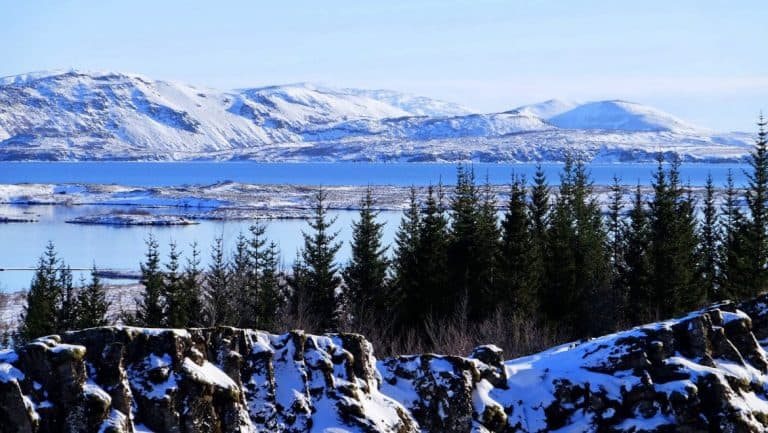
The geology of the park has been carved by the fury of the earth as the continental plates of North America and Eurasia drift apart. Here you can walk between two continents or stand on each and collect your certificate.
Take a dive in Lake Silfra, deep inside the rift valley. The lake is fed from melt-off from the Langjökull glacier, and because it is filtered through rock, it is crystal clear, with visibility of up to eighty metres. The colours of the water are breathtaking, with greens and blues of every hue.
The park is surrounded on three sides by mountains. It boasts extraordinarily beautiful scenery with moss covered lava, scattered with lakes and dotted with small birch forests.
Geysir Geothermal Area
The second stop on the Golden Circle tour, Haukadalur Valley is an area of intense geothermal activity and you can see the steam rising above it from miles away. The area is full of steam vents, pools of boiling water and bubbling mud pools which give vent to the pungent smell of sulphur.

This valley is the home of Geysir, the ancient natural wonder that gave its name to all other such phenomena. Geysir seldom vents anymore but Strokkur, alongside it, is very active and puts on a show several times every hour. Much to the delight of the onlookers, Strokkur catapults water and steam up to forty metres into the air.
Gullfoss
The last stop on the tour is the beautiful Gullfoss waterfall, one of Europe’s biggest, it drops down a thirty-two-meter two-tier fall.
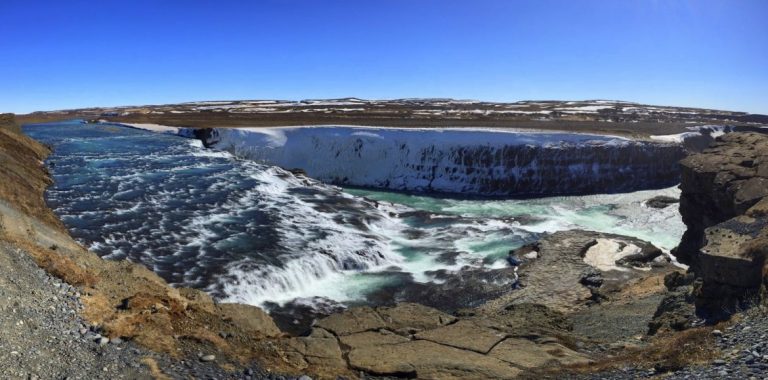
On a sunny day, its sparkling waters are dressed with rainbows.
Skaftafell Nature Reserve
Skaftafell Nature Reserve covers four thousand eight hundred square kilometres of land and encompasses black lava deserts, birch forests and moss banked roaring rivers. Waterfalls also grace the park. Enjoying milder climates than many other areas on the island, many people enjoy the camping facilities in the shadow of the Öræfajökull glacier.
The area is mountainous and includes the mighty Vatnajökull Glacier. This is a perfect place to take a glacier tour. Glaciers beautiful as they are from a distance, have so much more to offer up-close. They are moulded by the elements so that they change day by day, as tunnels and ice sculptures wax and wane.
Jokulsarlon Glacier Lagoon
Just sixty kilometres east, you’ll find the Jokulsarlon Glacier Lagoon. This beautiful blue lagoon is sprinkled with giant icebergs that have calved from the glacier icecap. This lagoon has become Iceland’s deepest lake, continually growing as the ice cap retreats. It is home to countless seals.

In the summer months, you can take a boat trip on the lagoon to view the seals and whales and to get close to the icebergs. In winter, you’re in for a treat of a different kind when the underground ice caves are open to tourist groups. Vatnajökull Ice Caves are formed in the summer months when melt-off from the glacier flows beneath the ice, creating a fairytale world of sparkling ice caves.
In wintertime ice chunks lay upon the black beach, glistening like diamonds.
Thorsmork
Thorsmork or Thor’s Park is a favourite hiking spot in Iceland. It is a place of incredible natural beauty and is a valley surrounded by three major glaciers. The green-clad mountains are threaded with streams and rivers. Waterfalls add to the dramatic landscapes. There are multiple ways to explore this area from hiking to modified jeeps, horseback riding, cycling or all-terrain vehicles.
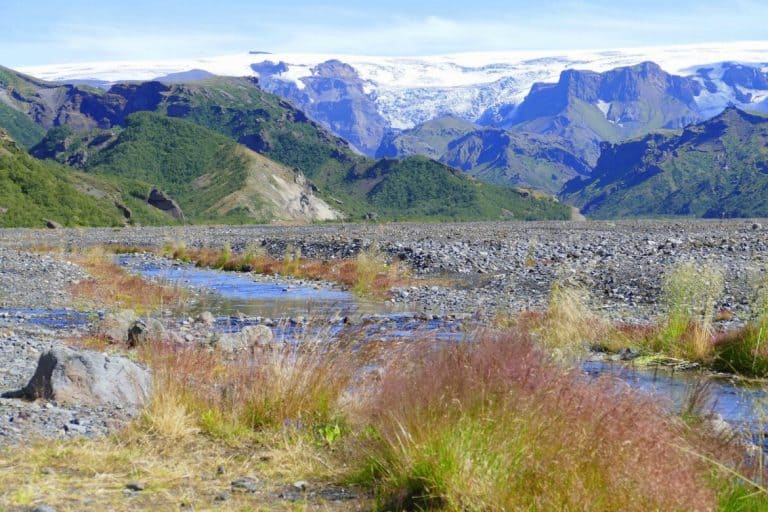
Volcano huts and campgrounds are available for overnight stays and there is a full restaurant.
Landmannalaugar
The Landmannalaugar mountain range stands in colourful contrast to the pitch-black lava field right next to it. These Rhyolite mountains are a singular sight, in shades of pink, yellow, orange and green, colours that change as the sun crosses the sky. The valleys below the bare slopes of the mountain are clad in bright green mosses and grasses and in spring, they are filled with wildflowers. Here the rivers run warm as the area is geothermally active, and you can find a number of warm spas to soak in. Huts and camping facilities are available. There is also a small supply store.
Reynisfjara Beach
The most famous beach in Iceland and one of the most picturesque, these black sand and pebble beaches are walled in by basalt pillared cliffs. Sea stacks rise from the furious Atlantic waters, which are famous for tossing rogue waves onto the blackened shoreline.
Try surfing
If you’re an adventurous type, a surfing trip to the Reykjanes Peninsula is well worth the effort. The view of the land from the sea is spectacular, and unlike other top surfing sites, you won’t be sharing your wave with anyone. Make sure to go out with an Icelandic surf expert as the weather and currents are unpredictable.
LAVA – The Earthquake Museum
The recently opened, Lava Volcano and Earthquake Museum features viewing platforms that overlook Eyjafjallajökull, Katla and Hekla. Here you can experience simulated earthquakes and volcanic eruptions. Interactive software explains the geology behind the phenomena.
North Iceland
Húsavík
Húsavík is one of the best places in the world to watch whales. The whales occupy the bay. The runoff from the surrounding mountains has endowed the lagoon with minerals that feed the plankton that the whales love. Boats of various types depart from the town into the lagoon so that visitors can get to see these animals close up, and in their natural environment. Humpback Minke and Blue Whale are frequently seen feeding and breaching in these waters.
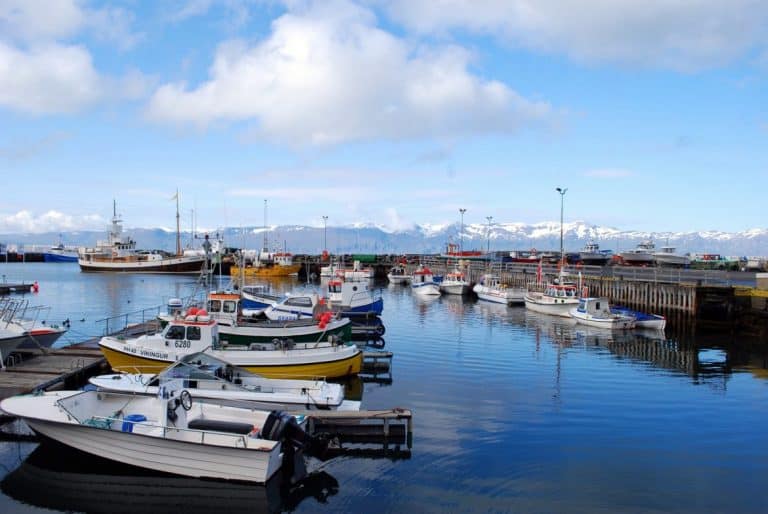
On the banks, you’ll find a colourful fishing village where you can visit the whale museum or finish the day sampling Icelandic fish dishes.
Lake Myvatn
Lake Myvatn was formed about two thousand five hundred years ago by a volcanic eruption. The lake district is rich with bird and animal life. It is a large shallow lake famed for its wide variety of ducks. The area has many bubbling mud pots and thermal pools, and the air is redolent with the pungent smell of sulphur.
Westman Islands
Just seventy kilometres off Iceland’s southern coastline, the Westman Islands comprise a group of thirty islands that are home to the biggest puffin population on earth. The largest, Heimaey, is the only populated island. It was devastated by a volcanic eruption in 1973. Many of the homes destroyed in the eruption remain as they were at the time. This place is now known as the Pompei of the North. Take a ferry to tour the islands.

Apart from the ruined town, you’ll also find an ancient Danish fort, some lovely churches, and ancient stone and turf houses so characteristic of Iceland.
Iceland – a Place Like No Other
Iceland is an extraordinary place with unusual and often otherworldly natural features seen nowhere else on earth. Here you can dive between continents, climb multi-coloured mountains, ride super jeeps through lunar landscapes, inspect icebergs and snowmobile on some of Europe’s biggest glaciers. Camp under the stars. Seek the Northern Lights. Ride an Icelandic horse through unspoilt nature. This is a holiday you’ll never forget.
Which would you prefer winter or summer in Iceland?


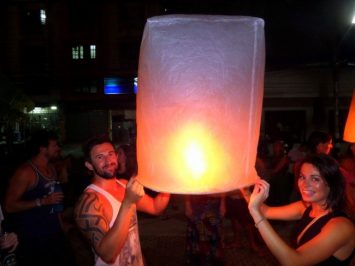
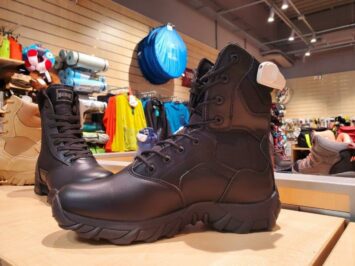
8 thoughts on “Iceland – An Adventurer’s Dream Destination”
Yes, Iceland! I hear it’s pricey but super safe and most people speak English fluently so meeting people and getting around is relatively easy.
I’m going to be visiting Iceland and Finland this year, I already can’t wait but your post has really got me excited. I shall try and tick off a few of these things and check back in after April if that’s cool with you.
Such beautiful place for an amazing adventures.
It’s amazing to think it was off people’s radar for so long. Such a stunning country. I’d love to photograph it one day …for at least a month it possible!
Awesome, Phil. I’m here if you need some help :) Good luck and have fun!
True! :-)
Hope you can make it there soon, Kathryn ;-)
Have you been there already? :)